Your baby’s teeth are starting to appear. When do babies start teething? What are the symptoms of a dental flare? How to ease the pain? When to consult?
Your baby’s teeth start to form during pregnancy. At birth, the baby’s 20 teeth, called primary teeth, are still developing under the gums. The young child’s diet influences the formation of his baby and permanent teeth.
When Do Babies Start Teething?
Babies start teething after the first teeth grow around six months of age. However, they may appear earlier or later, even up to 12 months. The lower front teeth usually pierce first.
Teething can go unnoticed or be accompanied by discomfort. From 4 months of age, it is normal for your baby to salivate a lot. When the teeth come in, he may drool more and feel the need to bite.
Your baby may also have red cheeks, have irritation around the mouth or face, be moodier, or refuse food. When the molars (the back teeth) are pushed, some babies touch their ears more because of the pain felt in this area. If these discomforts are significant, contact Info-Santé
In some children, a blue bubble (also called an eruption cyst) appears on the gums just before the tooth is pierced. In general, this bubble does not require any treatment. If necessary, consult a health professional.
Do not attribute fever, diarrhea, or red buttocks too quickly to tooth growth. Look for another cause instead.
TEETHING SYMPTOMS
Symptoms of teething. Teething has different effects on different babies. One chews things, frets, drools, has a hard time getting to sleep, and generally makes life miserable for the family for a month or two as each tooth comes through.
Another baby acquires teeth with no fuss at all. Teeth or no teeth, most babies start to drool at around three to four months as their salivary glands become more active. Don’t be fooled into thinking that drooling always means that teething has started.
Since babies get twenty teeth
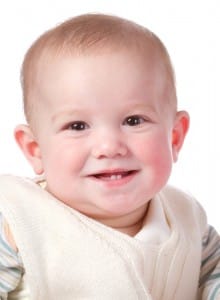
Since babies get twenty teeth in their first three years, it’s easy to understand why they always seem to be cutting teeth and why it’s so easy to blame every ailment on teething. Before viruses and bacteria were discovered, people thought teething caused colds, diarrhea, and fevers.
Some babies have facial flushing, drooling, irritability, ear rubbing, and mildly raised temperatures (less than 100.4°F) during teething.
Cough, congestion, vomiting, and diarrhea are not teething symptoms. Mainly, teething causes teeth! If your baby is sick, talk with the doctor; don’t simply assume that teething is the cause.
Help for teething. Any teeth may distress a baby, but the first four molar teeth, which erupt around twelve to eighteen months, are more likely to cause trouble than the others.
What to do? First, let her chew! Provide chewable objects that are dull and soft enough so that when she falls with them in her mouth, they won’t do any damage. Rubber teething rings of various shapes are good.
Avoid toys made from thin, brittle plastic, which could break and cause choking, and objects that might be coated with lead paint (that is, anything painted before about 1980, and possibly items imported from overseas). Board books are safe for babies to chew on; they’re lead-free and get soggy but don’t break into pieces a baby could choke on.
Cold things usually help.
Try tying an ice cube or a piece of apple in a square of cloth, or try the cool, damp cloth alone. Some parents swear by frozen bagels or frozen slices of banana. Be creative!
Many babies love to have their gums firmly rubbed. And don’t fret about germs on the teething ring or piece of cloth.
Your baby is putting all sorts of things in her mouth, none germ-free. Of course, it’s a good idea to wash the teething ring after it has fallen on the floor or after the dog has drooled over it.
Ask your child’s doctor before giving any medication for teething. Many teething gels on the market may offer some relief, but some contain potentially dangerous drugs.
A dose of acetaminophen can help with teething discomfort now and then, but even this safe medicine can be harmful if you give too much or for too many days.
HOW TEETH DEVELOP
Most babies get their first tooth at around six months, but occasionally a baby is
born with a tooth. Other babies are 12 months or older before their first tooth
appears. Your child should have all his primary teeth by the time he is 2years old
When teething, your baby will probably chew everything within reach and drool copiously and continually.
He may also be in pain, making him irritable, and one cheek may become flushed. However, he shouldn’t be running a fever, have a cough, or have any other serious symptoms; if he does, consult your doctor.
Baby Teeth Chart
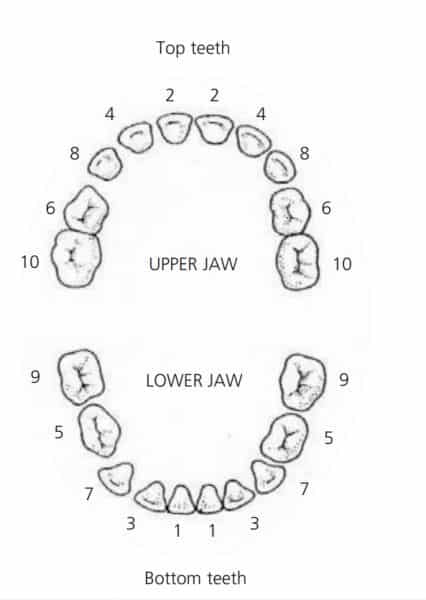
Your child’s primary teeth will probably appear in the following order:
- Lower central incisors (6 months)
- Upper central incisors (6 12 months)
- Lower lateral incisors (7 months)
- Upper lateral incisors (8 months)
- Lower anterior molars (10 months)
- Upper anterior molars (14 months)
- Lower canines (16 months)
- Upper canines (18 months)
- Lower second molars (2 years)
- Upper second molars (2 years).
Milk Teeth
Your child will have 20 primary teeth; the numerals indicate the order in which they should appear. He will start losing them when he’s about six years old.
Teething pain.
Teething is a common cause of pain in older babies. They can also cry from earaches and other illnesses. This is usually a more persistent cry, and your baby may be miserable
or inconsolable
Benzocaine teething gels are in many parents’ medicine cabinets, but I find they are a mixed blessing. Although they can reduce pain, they do it by numbing the mouth and causing that “just left the dentists? Feeling.
Some babies find this swollen, numb sensation as annoying as the teething pain. Also, the effect of teething gels is quite short-lived, and the gels carry a small risk of allergic reactions and decreased gag reflex.
Remedy. Babies’ painful gums are often soothed by a massage, so as the first line of treatment, rub the gums firmly but gently with a clean finger. You may find that your baby resists initially, but don’t give up immediately.
Many babies settle down and become relaxed as the massage continues. You can also offer your baby cold teethers to chew on.
However, remember that the toxic plastics in many baby toys (which contribute directly to the body and world pollution) are also found in some teething rings.
So, purchasing teething rings made of non-toxic plastics is important if you choose plastic.
I prefer organic cotton teethers. Or your baby might find relief just by chewing on a washcloth that has been moistened and cooled in the freezer.
This is a good idea if the washcloth is made from organic fibers. See the Buying Green Box “Baby Supplies for the Medicine Cabinet?” for safe teething products for your baby.
WHAT MAKES GOOD TEETH?
Nutrition for strong teeth. When Do Babies Start? Teething teeth need proper nutrition, including calcium and phosphorus, vitamin D, and vitamin C. Tooth development begins before birth, so pregnant women need to ensure they are getting all these nutrients.
Good sources of calcium and phosphorus include vegetables, cereals, calcium-supplemented juices, and milk. Sources for vitamin D include fortified milk, vitamin drops, and sunshine. Good sources of vitamin C include most fruits (especially citrus), vitamin drops, raw tomatoes, cabbage, and breast milk.
Timing is also important. Frequent snacking throughout the day encourages cavities. The mouth needs time to clean itself between meals. Young children need three meals and three snacks; older children should snack once or not at all. Sugary foods that stick to the teeth feed the bacteria that cause cavities.
Fluoride. It only takes a little fluoride in a mother’s diet during pregnancy and the growing child’s diet to make teeth decay-resistant. Fluoride is a naturally occurring mineral; we all have it in our teeth and bones. Fluoride makes the tooth enamel resistant to the action of acid.
If your water is low on fluoride, if your family mostly drinks bottled water, or if you use a home purification system that takes out all the fluoride and other minerals, then it makes sense for you and your children to use a fluoride supplement (drops or pills). It also helps to put fluoride directly onto the teeth through toothpaste, mouth rinses, or special preparations that dentists use.
Fluoride for babies and children.
If you’re breastfeeding and drinking fluoridated water, you don’t need to give your baby extra fluoride. If your water is not fluoridated, consider offering your baby an infant vitamin with fluoride.
Baby formulas do not contain much fluoride, but if you mix the formula with fluoridated water, your child gets plenty of fluorides. If not, consider adding fluoride drops.
When giving fluoride drops, it’s important to use the right amount. Too much fluoride can cause unattractive white and brown specks on the teeth. Your child’s doctor or dentist can tell you how much to give.
Fluoridated toothpaste strengthens tooth enamel, but too much fluoride can cause chalky or brown discoloration of the teeth. Children who eat toothpaste (that is, most young children) may get too much fluoride, so use a non-fluoride-containing toothpaste until your child is old enough to spit and rinse.
Once you change to fluoride toothpaste, put a pea-sized amount on the brush. It’s best to keep toothpaste away from a young child who might decide it’s delicious.
TOOTH DECAY
Bacteria and plaque. How does tooth decay happen? Bacteria in the mouth combine with food debris to form a material called dental plaque that sticks to the teeth. The bacteria make acid.
The acid dissolves the minerals that make up the teeth, eventually destroying them. The more hours of the day that plaque remains on the teeth, the greater the number of bacteria and the more acid they make.
The bacteria thrive on sugar and starch. Anything that keeps sugars sitting in the mouth is good for the bacteria and bad for the teeth. That’s why frequent between-meal snacking promotes tooth decay.
Especially harmful are lollipops, sticky candy, dried fruit, sugary drinks (soda and juice), and sweets like cookies and crackers cling to the teeth and are especially harmful.
Saliva contains substances that help teeth resist attacks by bacteria. Since the body makes less saliva during sleep, nighttime is when cavities are most likely to form. When children go to bed with food and plaque stuck to their teeth, the bacteria have all night long to do their dirty work.
That is why it is so important to clean may get too much fluoride, so use a non-fluoride-containing toothpaste until your child is old enough to spit and rinse. Once you change to fluoride toothpaste, put a pea-sized amount on the brush. It’s best to keep toothpaste away from a young child who might decide it’s delicious.
EARLY DENTIST VISITS
It’s a good idea to take your child to the dentist as soon as the first tooth erupts. Early preventive visits allow the dentist to detect problems when they can be solved more easily and painlessly.
A child who has had positive early experiences in the dentist’s office comes to look forward to dentist appointments, not dread them. Most future visits will be preventive rather than the traditional “drill and fill? sessions that haunt the childhood memories of so many adults.
Early care is especially important if you have had bad dental experiences. Tooth decay and gum disease are often passed from parent to child. Early care can help your child take a different path.
If your child has dental problems, you must develop a relationship with a dentist you can trust. More and more dentists see it as their job to create a “dental home? for each child, just as pediatricians try to make a “medical home? Certainly, if dental troubles run in your family, then a dental home is what your child should have.
MY BABY IS TEETHING. WILL HE BITE ME WHEN I FEED HIM?
He may. His gums can be sore at around six months, just before a tooth erupts, but teething can happen earlier. He’ll probably be gnawing on everything within reach at this stage, and your nipple is no exception. Just react naturally: yelp with pain, take your baby off the breast for a few minutes, and say, “No? to him. He’ll soon stop biting. Offer a teething ring between feedings.
Caring for primary teeth
How can I help my child have healthy teeth?

Start brushing your baby’s teeth in the morning and evening as soon as they appear. Initially, you can hold him on your lap and brush from behind.
When he’s old enough to sit or stand unaided, brush from the front. Even when he can brush by himself, you should supervise his technique. Only give fruit juice at mealtimes and avoid bedtime drinks unless he brushes afterward. If your child has sweet food, get him to eat it all at once rather than lingering over it.
Encourage him to choose healthy snacks and ensure his diet is rich in calcium, minerals, and vitamins. Begin dental checkups at an early age.
Are carbonated diet drinks better for teeth?
No. Carbonated diet drinks don’t contain sugar, so you might think they’re tooth-friendly, but their acidity makes them harmful when dissolved; carbon dioxide makes carbonic acid. Put a coin into a diet drink and watch it being eaten away.
Does my child need fluoride drops?
It depends on where you live. Sometimes fluoride is
It is already in the water, either naturally or because the water provider has added it.
If your area doesn’t have fluoride in the water, your child may need drops from baby hood onward. Too much fluoride may discolor the teeth permanently, so don’t give fluoride drops without first seeking advice from your doctor or pediatrician.
Can medicines affect my child’s teeth?
All medicines containing sugar can hurt a child’s teeth. Many are now available in sugar-free formulations that still taste good to children. Ask your doctor or pharmacist for sugar-free alternatives whenever possible.
Some antibiotics can also be detrimental to dental enamel, especially tetracycline. This is why they shouldn’t be given to children under 12 years old, pregnant women, or breastfeeding.
TEETHING FOODS
When Do Babies Start Teething? Around four months, teeth can start to emerge; by age three, all twenty primary teeth will be in place. To prevent cavities, you will want to start keeping teeth clean as soon as they appear.
A teething baby will love to put everything in her mouth. Ask your doctor about the use of products such as Orajel or Anbesol. These can give temporary relief but also interfere with chewing ability because they cause numbness.
This could be a significant problem because almost any food used as a teething ring, such as a bagel, can quickly turn into a mushy, gooey substance that can be difficult to swallow.
Many parents turn to the Baby Safe Feeder. This baby-safe bag holds the food and allows juices to be squeezed out but is too large to be a choking risk. These did not exist when I had my children, but they make a lot of sense.
Used a clean new sock filled
I used a clean new sock filled with crushed ice and tied it at the end instead as a teething ring. Cold, chewy food can give relief, but when my girls were little, I let them chomp on a clean, damp washcloth or a clean adult-size toothbrush.
Of course, never leave your little one alone while she has teething food or an object in her mouth.
The eruption of teeth is no reason to stop nursing. If your baby bites down while nursing, teach her not to do this by using your pinky finger to break her mouth’s suction on your breast. Quite quickly, a child learns to stop this habit.
To prevent the rash that often develops with the constant drooling accompanying teething, pat your baby’s chin dry as often as possible, and put a thin layer of baby oil on the chin to prevent irritation.
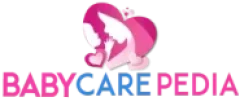
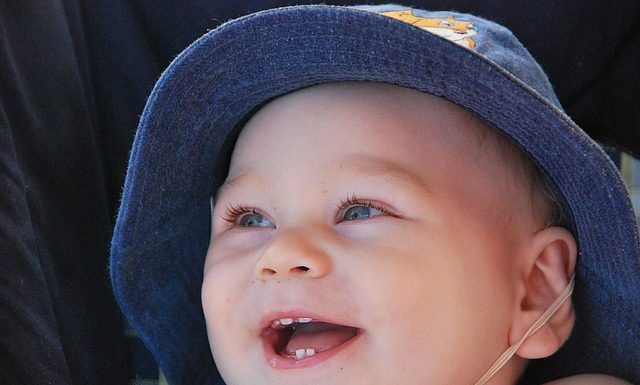
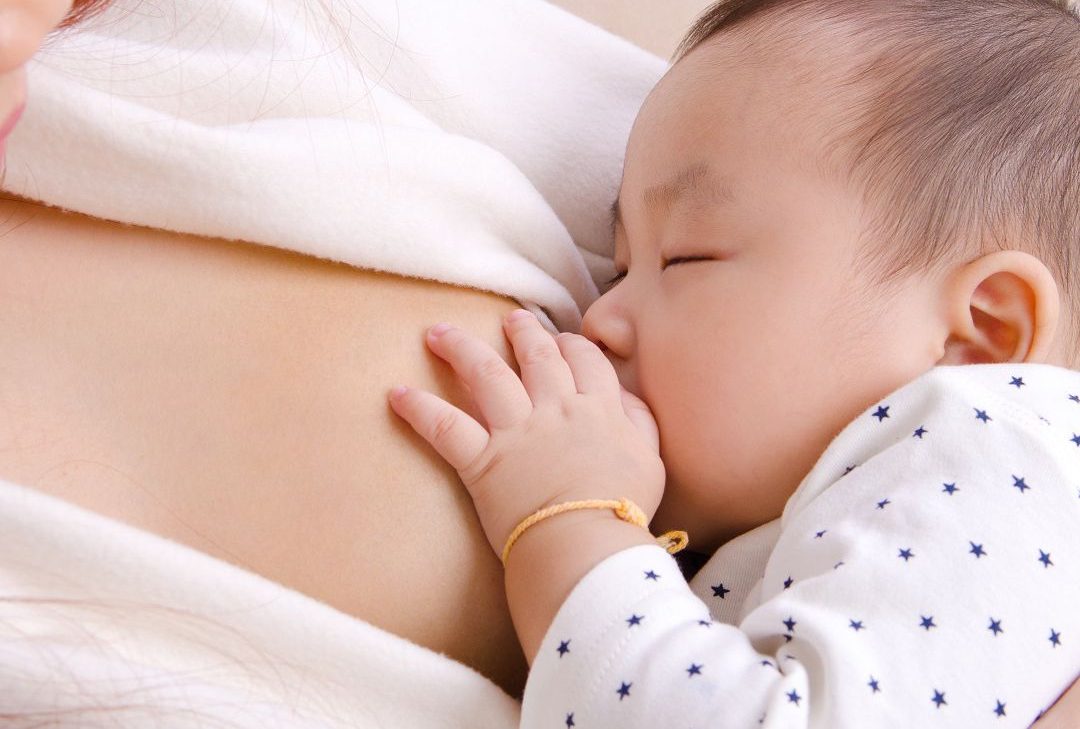
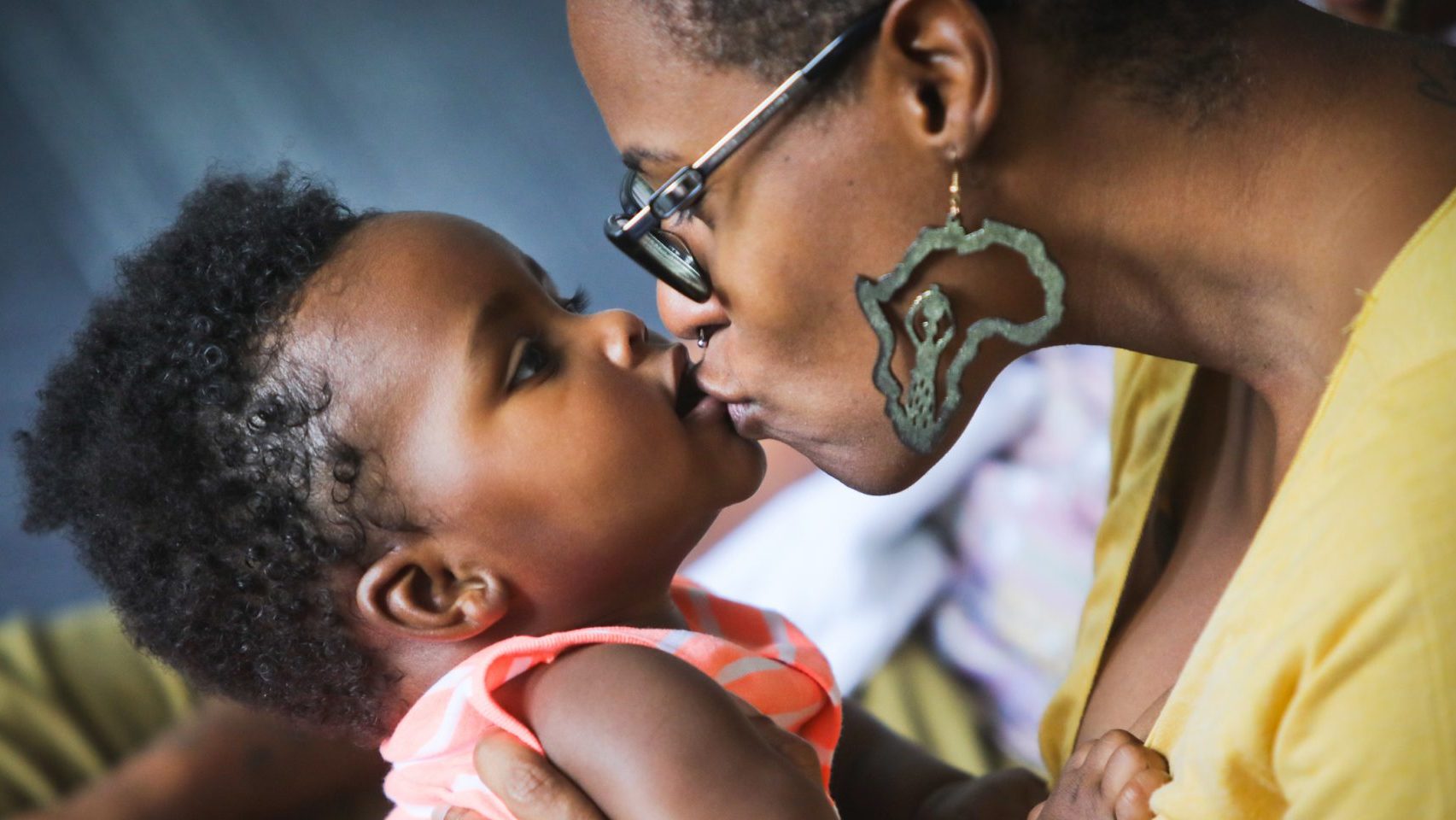
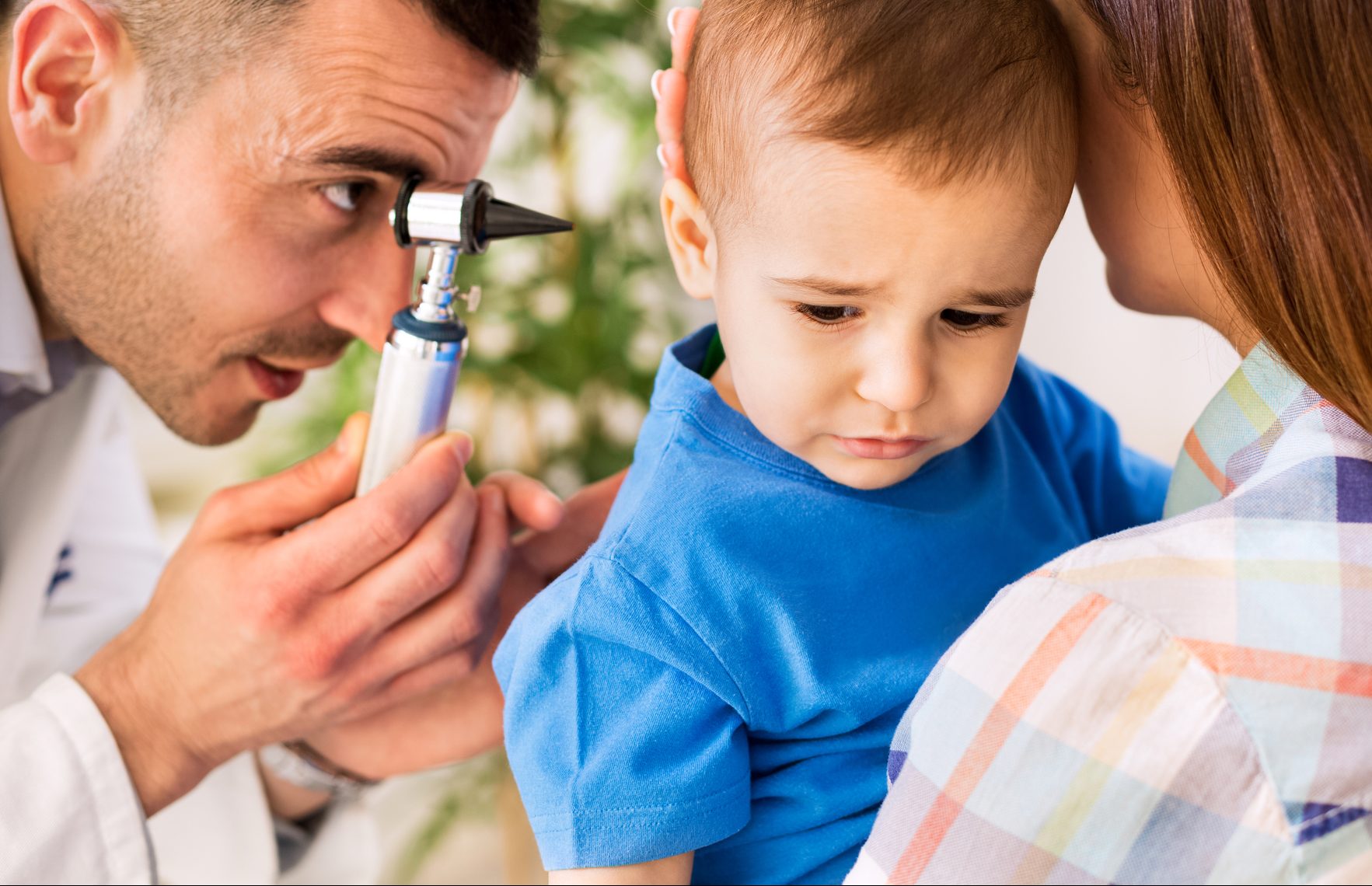
1 thought on “When Do Babies Start Teething? Here’s what you need to know ”
Comments are closed.